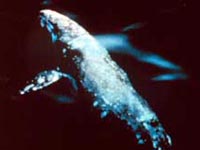This article is reposted from the old Wordpress incarnation of Not Exactly Rocket Science.
![]() Twenty-two thousand sounds like a huge number. It's happens to be number of eastern Pacific gray whales currently swimming off the coast of North America. It's certainly much larger than 140, the number of whales that aboriginal people of this area are allowed to hunt. And it's far, far bigger than zero, the population size that the whales were rapidly approaching in the mid 20th century.
Twenty-two thousand sounds like a huge number. It's happens to be number of eastern Pacific gray whales currently swimming off the coast of North America. It's certainly much larger than 140, the number of whales that aboriginal people of this area are allowed to hunt. And it's far, far bigger than zero, the population size that the whales were rapidly approaching in the mid 20th century.
 Obviously, it's all relative. Twenty-two thousand is still much less than ninety-six thousand. That's the size of the original gray whale population and it's three to five times the current count. Not exactly cause for conservational complacency, then.
Obviously, it's all relative. Twenty-two thousand is still much less than ninety-six thousand. That's the size of the original gray whale population and it's three to five times the current count. Not exactly cause for conservational complacency, then.
Previously, conservationists and whalers alike could only speculate on the number of whales that lived before their flirtation with extinction. But now, Elizabeth Alter and Stephen Palumbi from Stanford University have managed to pin down a figure by looking at the genetic diversity of living whales. And their results suggest that despite a rebound that Hollywood would envy, the grays are still a pale shadow of their former strength.
The gray whale is often touted as a poster child for successful conservation. In the 19th century, they were hunted to near extinction by eager whalers, but they were given a new lease of life in 1949, when the International Whaling Commission granted them protection from hunting. Today, the western Pacific population remains critically endangered, but the eastern Pacific whales have bounced back. On average, recent censuses put their numbers at about 22,000. Despite once skirting the brink of extinction, the eastern Pacific gray is now the most common whale in the western seaboard.
Cries of 'full recovery' were sounded, bolstered by the fact that several gray whales have recently been seen suffering from starvation. The assumption was that they had reached a population plateau, filling up the ecological niche that can support their large bulk. Even the American Cetacean Society claims that the whales are 'probably close to their original population size.'But Alter argues that these celebrations are premature.
She notes that we can't truly claim a full recovery without knowing how large the whales' initial populations were before the whalers took their toll. But that's not something we can just look up - no whale censuses existed in those days. Indirect measurements will have to do.
 Alter and Palumbi realised that a species' genetic diversity increases over time as their population grows. They compared the amount of genetic variation in 42 living whales at ten different parts of their genome. By looking at the rate at which these segments change (or mutate), they back-calculated the size of the ancestral shoals.
Alter and Palumbi realised that a species' genetic diversity increases over time as their population grows. They compared the amount of genetic variation in 42 living whales at ten different parts of their genome. By looking at the rate at which these segments change (or mutate), they back-calculated the size of the ancestral shoals.
They found much more variation in the whales's genes than expected - too much for a population of a mere 22,000. Alter and Palumbi estimate that the whales once numbered 76,000 to 118,000 individuals, about 3 to 5 times more than the current level.
The researchers admits that in the absence of historical records, their figures will only ever be estimates. But they have acknowledged and accounted for potential sources of error, including different mutation rates and unusual population structures.
In most cases, these factors would only serve to increase Alter's estimates, and in others, she took the most conservative estimate. Despite these allowances, even her lowest possible population tally (44,000) dwarfs today's count by a factor of two.
According to these figures, the current population is nowhere near a population limit. Indeed, recent ecological surveys suggested that the whales' Arctic feeding grounds could support about 90,000 of them. Alter and Palumbi suggest that the starving whales of recent reports are the victims of climate change, suffering from a lack of food as the numbers of prey animals in the Arctic falls.
The big worry is that their ecological niche has shrunk permanently. Their population crash could have rippled through the food web and created conditions which can now support a fraction of the original whale shoals. And the rise and fall of the whales also affects the fates of several other species.
 Gray whales are, quite literally, 'bottom-feeders'. They feed by raking up large mouthfuls of sediment from the sea floor and filtering out the delicacies buried within. As a result, they rake up huge volumes of sediment and release nutrients back into the water. The population of 96,000 whales would have suspended more sediment into the water in a year than the entire Yukon river could in twelve. The loss of some 70,000 of these could have seriously lowered the capacity of the waters to sustain life.
Gray whales are, quite literally, 'bottom-feeders'. They feed by raking up large mouthfuls of sediment from the sea floor and filtering out the delicacies buried within. As a result, they rake up huge volumes of sediment and release nutrients back into the water. The population of 96,000 whales would have suspended more sediment into the water in a year than the entire Yukon river could in twelve. The loss of some 70,000 of these could have seriously lowered the capacity of the waters to sustain life.
The whales' bulldozing style also launches buried crustaceans into the water and these are picked up by opportunistic seabirds. In this way, the original whale population could have inadvertently provided food for over one million birds. Finally, their massive bulks could have fed scores of killer whales, while their beached carcasses provided rich pickings for scavenging condors.
The gray whale is definitely a conservation success story, but it's not out of danger yet. Whaling countries are keen to hold up recovered populations as reasons to increase the numbers that they are allowed to hunt. But if Alter and Palumbi, the existing quotas could be called into question themselves.
For now, the more pressing concern is to work out why the eastern Pacific gray population has yet to return to its prime, and what that means for the oceans. Palumbi likens the whales to massive seagoing canaries - they are sensitive to the ecological health of the oceans. If they are struggling to reach their former glory despite our best efforts, something must be wrong.
Reference: Alter, Rynes & Palumbi. 2007. DNA evidence from historic population size and past ecosystem impacts of gray whales. PNAS doi/10.1073/pnas.0706056104




And how does the massive amount of plastic waste in the Pacific affect creatures who feed as this whale does? Could that account for the signs of starvation in some?
Plastic waste is one item; I'd be interested in learning to what degree the gray's feeding habits roil once dormant toxins, perhaps enabling other creatures to feed on it as well.
If this is not a real concern, that's good to know, too, I guess.
It makes intuitive sense that bottom trawling (links: http://en.wikipedia.org/wiki/Trawling ; http://www.livescience.com/environment/080220-trawling-effects.html ) would negatively impact the food chain of gray whales; I wonder how much this technique is used in the range of N.Atlantic grays.
I had a chance to talk to Palumbi briefly a year or so ago at a documentary presentation. I asked whether the figures could be skewed by mixing with western gray whales, which haven't recovered at all, and he said that was possible.
I think some more research might be necessary before we can conclude definitively that the eastern population is stuck at a much smaller fraction of carrying capacity than it had prior to hunting.